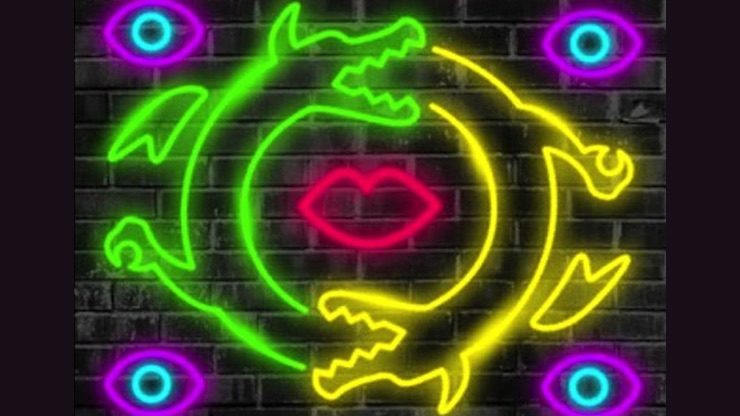There have been a lot of books heralded as heirs to Infinite Jest, but I can happily say: this is it. I’ve found it.
After all the years of doorstopping tomes writing by white literary fiction males (many of whom I love) and all the years of terrified readers being cornered in coffeeshops by wild-eyed young men (and occasionally, um, me) who needed to explain David Foster Wallace’s masterwork, Chandler Klang Smith has unleashed her own slipstream, genrefluid monster of a book—that also happens to be fun, visceral, heartbreaking, and genuinely funny. The Sky Is Yours is bursting with ideas and characters, and I’d advise you take a break after reading it, because other books are probably going to seem a bit black-and-white for a while.
Buy the Book


The Sky is Yours
Here are the basics: Empire City seems to be a far-future and/or alt history Manhattan. After decades as a cultural center and industry powerhouse, the city’s fortunes changed when a pair of dragons rose from the sea and began torching everything in sight. One is green and one is yellow; they never sleep, they never eat, they never mate, they never land, they never die. They are constantly vigilant and, as far as anyone can determine, invulnerable. By the time this story begins, the citizens of Empire City have given up hope of ever escaping their shadow. A penal colony called Torchtown operates under its own rules, rich people hide themselves in The Heights or the rural landscape of Wonland, and most of the middle class has fled for safer, less burninated climes.
We’re brought into this world by Duncan Humphrey Ripple V, a callow young man who rose to fame as a teen star of a “Toob” series called Late Capitalism’s Royalty (which is exactly as gross as it sounds), and is now being forced into anonymity by his perpetually embarrassed, be-tracksuited father, Humphrey. Duncan’s fiancée, the Baroness Swan Lenore Dahlberg, is a death-obsessed romantic who is none too sure she likes her betrothed. Finally there’s Abby, a feral girl whom Duncan finds in a landfill and brings home like a lost kitten. When tragedy strikes the Ripples the three teens have to try to make lives for themselves, and we follow them on their journey from the Ripples’ cliffside compound down into The City itself, with all of its dangers, mob bosses, and occasional dragon attacks.
Smith’s language is incandescent, but more important it’s fun: a toupee is described as a “skull-merkin,” a woman’s voice is “as sharp as vodka cracking ice,” home tooth extractions are treated in such granular fashion that I think I could do one myself. The Metropolitan Library’s front steps are flanked by stone gryphons, rather than the lions of the New York Public Library. And when someone falls from a height and dies, she’s describes as “melting into a pool of herself.” Smith floats easily in and out of characters’ heads, and also tells some sections from a sort of collective voice of the city. These chapters are particularly stirring and panoramic, and I realize it’s a little cliche but the city truly does become its own character. The worldbuilding is exactly the kind I like: it answers many logical questions like, What poetry is written by a dying society? What urban legends spring up when dragons soar overhead? How has technology changed humanity? But it never becomes airless or claustrophobic. There is just a tinge of a Handmaid’s Tale scenario—an older woman refers to her past in marketing, and refers to herself as the last female valedictorian of a business school, and nearly all the other women we meet are either marrying for money or depending on men for their safety. But nothing is set out in stone that women have fewer rights, or are oppressed—simply the more insidious erosion of rights and autonomy that often come in unsettled times. Somehow this is almost more horrifying? The idea that women have dropped to a lower level of society in the wake of the drakes. Stylistically speaking Smith goes HAM, peppering epic poems, execrable rap lyrics, flowcharts and urban legends across the story. If a character decodes to pretend he’s a videogame avatar in order to get through a task, then you’re going to read his experience like commands on a screen. If a woman sees herself as a Regency heroine adrift in time, you’re going to get some high-toned, flowery language.
None of this is at the expense of character. Smith dives from consciousness to consciousness, giving us a teeming cast of characters, and seems to take special pride in presenting us with someone we’ve seen before: goldigging stripper; Youtube-addled manchild; mob boss; preening aesthete. But then she throws them all together in a world that doesn’t make sense, and peels the layers or their personalities back until you’ve found a new best friend. Is Swan Lenore an overemotional brat? Hell yeah, but she’s also the daughter of a poet, a living, breathing person, who is perpetually disappointed that the Toob-addicted modern world refuses to live up to her Gothic novels:
The women in the books sometimes had mysterious ailments, treated with laudanum or heated water; they went mad, drank poison, bungled abortions, and went to the countryside for their health. Sometimes they drowned: seaweed mingled with their hair in thick dark strands while their eyes gazed on, sightless and knowing; sometimes they wasted away. More than one coughed blood into a handkerchief. More than one owned a pearl-handled revolver. But in none of these books did a woman have thirty-two teeth in her head, seventy-four more in a box, and a new one on the way In none of the books did a woman have a dentist living in her house.
Swanny also, for reasons I shall not spoil, has more than the normal number of teeth.
The three young people have to contend with a possible conspiracy, the remnants of the city’s old dragon-fighting brigade, creatures who may be human/machine hybrids, a personality that might be the City itself, and always overhead there are monsters, torching seemingly at random, a constant existential threat that none of them can contemplate directly. As in many of my favorite books, the only way to deal honestly with the modern world is to push things even further. Which is why Infinite Jest kept springing to mind, because it was the first book I read that did this for me. The first one that felt more like reality than, well, reality. So seeing a similar commitment to excess made me like Smith’s book more with each page. If you’ll indulge me in a shout-out to an especially fun David Foster Wallace reference: On page 154, Smith includes a partial list of Duncan Ripple’s pornography holdings. I read this with a wide grin on my face, recognizing the riff on Infinite Jest’s complete filmography of James O. Incandenza (the deceased father of one of Jest’s main characters), but that grin got a lot wider when she included the title “Big Red Son”—which is also the title of Wallace’s seminal 1998 essay on the Adult Video News Awards, which are essentially the Oscars for porn. And then, as if that wasn’t cool enough, she slipped in a Dune reference with the title “Riding the Worm.”
Did I mention I enjoyed this book?
Now none of this is to say that The Sky is Yours is perfect (but what would that even look like?) and I do mean overstuffed as a compliment, but there are points when the story strains at the seams. When you’re juggling this many threads and hopping between dozens of heads, things can get a bit tangled. But overall Smith balances well between the characters and their arcs, especially a gripping sequence about Swanny that left me equally entranced and repulsed. There were times I realized I was reading so fast that my brain couldn’t catch up with my eyes, and I finally had to force myself to slow down and reread an entire section—any book that can capture me that much is one I’m going to recommend. But more than that, with Sky, Smith seems to be grappling with some huge ideas. The dragons are “hyperobjects” in the same was Mord is in Jeff VanderMeer’s Borne—impossibly large, unpredictable, and most of all: unnatural. In a world of man-made monstrosities and mutations, for creatures from myth to rise from the sea an present themselves to soft, tender human brains…it’s just too much.
Because of this the dragons can stand in for a lot of different things, but I’d simply say that the dragons are REALITY. Reality that the older, moneyed generation is no more equipped to handle than their vapid sons and daughters. All of the characters lose themselves in different types of fantasies, fairytales, porn, reality TV, mountains of drugs, and Smith makes sure this is fun for large portions of the book. But then every once in a while she’ll pull her own curtain back a little with a scene like this:
“See that one there?” asks Sharkey, pointing to a curving cylindrical colossus of red enamel and steel, now as used up as a drained Voltage can. “That’s the Lipgloss Building. It was the first one They hit.” He says the pronoun with a capital letter, as if he’s referring to the gods. “Fifty years ago now, and it’s still standing. All those little people, jumping out the windows. Their best thinking got ‘em there. Offices up in the sky no better than a prison. A fuckin’ kiln. And the only view was down. Makes ya think. I wasn’t even born yet, old as I am. Up there, people though they were living in the future. But they were living in the past. We’re living in the past too, you and me. That’s why it’s good to pay your respects. Take note of what’s come before, because pretty soon, somebody’s coming after you.”
Swanny gazes at a fallen column of imperial granite lying on the curb. “Was there a great deal of screaming, do you think?”
“Screaming? Oh, sure. Lots of screaming. It’s a natural response to untold horrors. Close your eyes and scream. No seeing, no hearing. Gives you a little relief. Relief, not release.”
Swanny holds out her cup as Sharkey refills it. Her eyes cling to the building a it slips out of view. “I feel somehow that they’re screaming still.”
“Once something’s happened, it’s happened for all time.”
Obviously this can be seen as a terrorist attack, or a natural disaster, or simply the inevitability of time’s passage, but Smith attacks the problem by looping the concern with death and time intimately into the architecture City itself. Her characters respond to the reality of the dragons through different forms of escapism, whether money, porn, games, gargantuan piles of drugs, but she allows her satire of the callow and the rich to slip just enough that we can see the real depth and sorrow that lurks beneath. The Sky Is Yours may be a rollicking adventure, but it also has a bracing, honest heart.
The Sky is Yours is available from Hogarth.
Leah Schnelbach thinks more literary fiction should have dragons—they seriously improve everything. Come breathe fire with her on Twitter!










